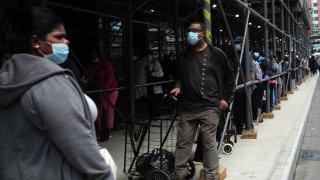
NEW YORK, NEW YORK – MAY 15: Over one thousand individuals wait in line at the Barclays Center in Brooklyn for a free food distribution on May 15, 2020 in New York City. The event was organized by Food Bank for New York City and included fresh produce items and meat. The sports arena in downtown Brooklyn, now closed, saw lines wrap around the block as New Yorkers struggle with unemployment and other financial stresses brought on by the COVID-19 outbreak. Across America, cities and towns are dealing with some of the highest unemployment rates since the Great Depression.
The coronavirus has cut an unequal path of grief through New York City, hitting hardest in a ring of predominantly poorer, nonwhite neighborhoods a long subway and bus ride from Manhattan, according to data released by the city Monday.
The worst hit ZIP code based on cases per 100,000 is 11369 in West Queens, with 4,125. Four of the hardest hit ZIP codes are also located in West Queens, with the others located in northeast Bronx and Canarsie-Flatlands. Based on fatalities, ZIP code 11239 in Canarsie-Flatlands was hit worse than any other place in New York with 612 deaths per 100,000 residents.
The new accounting of fatalities by neighborhood revealed that ZIP code is the one that contains Starrett City, a huge complex of apartment towers in Brooklyn that is the largest federally subsidized housing development in the country.
Of the area’s roughly 12,400 residents, 76 have been killed by the virus. Nearly 63% of the people living in the ZIP code are black. It is also the ZIP code with the largest percentage of older people in the city, likely a contributing factor in the high fatality rate.
Other areas of the city with unusually high death rates shared some characteristics with the complex, which is in a far-flung part of Brooklyn not far from Kennedy Airport.
Brooklyn’s Coney Island and the Far Rockaway section of Queens both had high fatality rates, as did the northeastern-most parts of the Bronx, including Co-Op City, another huge apartment development upon which Starrett City was modeled.
The data released Monday reinforced earlier revelations that black and Hispanic New Yorkers were both more than twice as likely to be killed by the virus as white people.
And it also showed a direct link between death and poverty.
News
Neighborhoods with very high poverty levels suffered an average of 232 deaths per 100,000 residents while areas with low poverty rates experienced 100 deaths per 100,000 residents.
Mayor Bill de Blasio said in an interview on NY1 late Monday that part of that is a result of the "really painful, really unfair history of race and class" in the city and country, and said the same health disparities we've seen previously are also playing out with coronavirus.
"I think so many people we lost never had the opportunity even to have the basics of high-quality health care and that underlies this whole crisis," de Blasio said. ""It tracks with everything we've ever known about economic and health disparity."
Jonathan Westin, executive director of New York Communities for Change, a group that advocates for low-income communities, called the disparities devastating. He said Gov. Andrew Cuomo and Mayor Bill de Blasio, both Democrats, could have lessened the impact of the pandemic on the poor.
“It’s a crisis that they haven’t canceled rent for the millions of people who have no jobs or are forced to go to work because they can’t pay their rent and are living in overcrowded situations already and then bring the coronavirus home because they have to work, they have to make rent, they have to live,” Westin said.
COVID-19 has killed at least 15,233 New York City residents, plus nearly 5,000 more whose deaths weren’t immediately confirmed by a lab test.
Here's a list of the 10 hardest hit ZIP codes in New York City (along with the number of fatalities per 100,000 residents):
- Canarsie-Flatlands, Queens - 11239 (612)
- Rockaway, Queens - 11691 (445)
- Flushing-Clearview, Queens - 11354 (434)
- Northeast Bronx - 10469 (429)
- Coney Island-Sheepshead Bay, Brooklyn - 11224 (416)
- West Queens - 11369 (411)
- Rockaway, Queens - 11692 (383)
- Northeast Bronx - 10457 (354)
- Stapleton-St.George, Staten Island - 10304 (353)
- West Queens - 11372 (348)